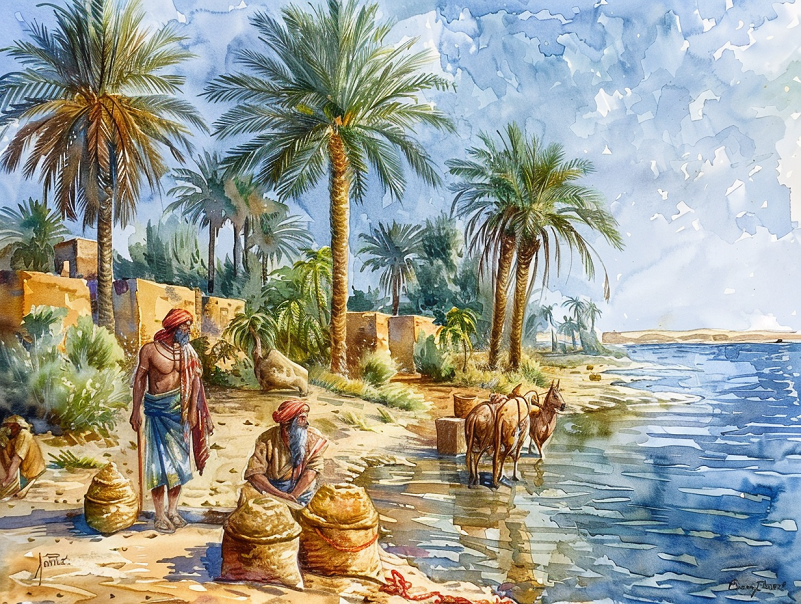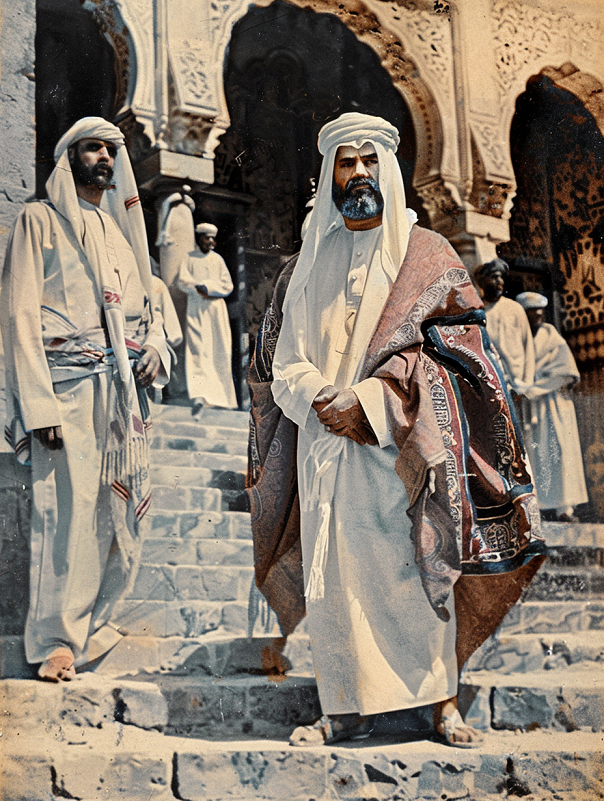The island nation of Bahrain, nestled in the waters of the Persian Gulf, has a rich tapestry of history that is intrinsically linked to the Al Khalifa dynasty. This ruling family, originating from the Anizzah tribe in the Najd region of what is now Saudi Arabia, embarked on a remarkable journey that saw them establish dominance over Bahrain in the late 18th century. Their ascent to power is a narrative filled with strategic alliances, military conquests, and political sagacity, amidst the shifting sands of regional rivalries and colonial interests. Key figures such as Sheikh Ahmed al-Fateh, pivotal events like the battle of Zubarah, and the strategic use of “pearling” underscore the dynasty’s foundational role in Bahrain’s emergence as a significant Persian Gulf entity.
Bahrain’s strategic position in the Persian Gulf has historically made it a nexus of trade, culture, and conflict. Long before the modern era, it was celebrated for its lush palm gardens and as a centre of ancient civilisations, such as Dilmun, which connected Mesopotamia to the Indus Valley. Into this historical and geographical tapestry, the Al Khalifa dynasty wove its narrative, rising from the ranks of the Anizzah tribe to become the sovereigns of Bahrain. The family’s tale is emblematic of the Arabian Peninsula’s complex tribal dynamics and the broader geopolitical machinations of the 18th century, a period marked by the ebb and flow of empires and the quest for regional dominance.
Pre-Al Khalifa Bahrain
Before the Al Khalifa’s ascendancy, Bahrain was a land of considerable wealth and strategic importance, renowned for its pearling banks which attracted various powers. The islands had seen the influence of the Portuguese and Persians, each leaving an indelible mark on its socio-political landscape. The lucrative pearling industry, in particular, became the lifeblood of Bahrain’s economy, making it a coveted prize among regional contenders. This period laid the groundwork for the Al Khalifa’s eventual emergence, providing a backdrop of economic activity and political intrigue.
The Arabian Peninsula’s Tribal Dynamics
The 18th-century Arabian Peninsula was a mosaic of tribal affiliations and loyalties, characterised by frequent skirmishes and shifting alliances. The Al Khalifa, part of the Bani Utbah confederation, were one of many tribes navigating this volatile environment. Their decision to migrate and seek new territories was driven by both ambition and survival, reflecting the broader patterns of Arabian tribal movements. This era of inter-tribal warfare and strategic marriages set the stage for the Al Khalifa’s move towards Bahrain, illustrating the intricate web of relationships that would define their rise to power.
Origins of the Al Khalifa Dynasty
The Al Khalifa dynasty’s roots can be traced to the Anizzah tribe, a significant and influential group within the Arabian Peninsula’s tribal landscape. The Anizzah’s wide-ranging presence, from the Najd region to parts of modern-day Syria and Iraq, underscores the tribe’s adaptability and prowess. Within this context, the Al Khalifa emerged from the Bani Utbah, a confederation that played a crucial role in their early history. This lineage imbued the Al Khalifa with a robust network of tribal alliances and a reputation for martial and diplomatic skill, setting the stage for their eventual migration and conquests.
Migration from the Arabian Peninsula
The Al Khalifa’s journey to power began with their strategic migration from the Najd to Qatar, Kuwait and finally to Bahrain. This move was motivated by a combination of factors, including the search for new resources, the desire to escape from prevailing conflicts, and the ambition to carve out a realm of their own. The battle of Zubarah in Qatar notably marked a significant early military success for the Al Khalifa, demonstrating their martial capabilities and strategic acumen. This victory not only enhanced their stature among the Gulf’s tribes but also provided a springboard for their eventual conquest of Bahrain. The migration reflects a broader pattern of Arabian tribal movements, driven by the search for prosperity and security in a turbulent region.
Key Figures in the Early History
Among the early luminaries of the Al Khalifa dynasty, Sheikh Ahmed al-Fateh stands out as a foundational figure. Known as “the conqueror,” his leadership was pivotal in the capture of Bahrain from Persian control in 1783. Sheikh Ahmed’s vision and military prowess were instrumental in establishing the Al Khalifa’s rule over the islands, marking the beginning of their ascendancy in Bahrain. His strategies and alliances laid the groundwork for the dynasty’s long-term stability and growth, embodying the qualities that would come to define Al Khalifa governance. His legacy, both as a warrior and a statesman, continues to be celebrated in Bahrain’s history, symbolising the dynasty’s enduring connection to the nation’s identity.
1783 Conquest of Bahrain
The allure of Bahrain for the Al Khalifa dynasty lay not only in its geographical position but also in its economic potential. Situated at the heart of the Persian Gulf, Bahrain’s islands were a pivotal maritime crossroads, facilitating trade routes that spanned from the Arabian Peninsula to South Asia. Moreover, the archipelago’s pearling banks were among the most productive in the world, promising wealth and prosperity to those who could control them. This combination of strategic and economic incentives drove the Al Khalifa’s ambition to establish their dominion over Bahrain, recognising its potential to serve as the cornerstone of their burgeoning maritime empire.
The Military Campaign and Battles
The military campaign to seize Bahrain was characterised by a combination of naval prowess and strategic land engagements. The pivotal moment came in 1783 when Sheikh Ahmed al-Fateh led a decisive assault against the Persian garrison on the island. Utilising a fleet that had been meticulously assembled over the years, the Al Khalifa forces landed on Bahrain, engaging the Persians in a series of battles that culminated in the capture of the island. This victory was not merely a testament to their military might but also to their strategic planning and the effective mobilisation of tribal alliances. The conquest of Bahrain marked a significant expansion of Al Khalifa power and heralded a new era in the Persian Gulf’s geopolitical landscape.
Alliances and Conflicts with Regional Powers
The Al Khalifa’s rise to power in Bahrain was further shaped by their adept navigation of the complex web of regional politics. Their initial conquest was facilitated by alliances with other Arabian tribes, leveraging shared interests and familial ties to consolidate their military efforts. However, the newfound control over Bahrain also introduced the Al Khalifa to new challenges, including managing relationships with regional powers such as the British and the Ottomans. The British, in particular, emerged as a crucial partner for the Al Khalifa, offering protection agreements in exchange for influence over Bahrain’s foreign policy. These alliances and conflicts underscored the diplomatic agility of the Al Khalifa, allowing them to secure their position in Bahrain while navigating the ambitions of larger imperial powers.
Establishment of Governance Structures
Following their conquest of Bahrain, the Al Khalifa dynasty set about establishing a structured governance system to unify and administer the islands effectively. This involved the creation of administrative divisions and the appointment of family members to key positions of authority, thereby ensuring loyalty and the efficient implementation of policies. Central to this effort was the establishment of Manama as the political and economic capital, from which the Al Khalifa could exert control over the archipelago and manage its burgeoning trade and pearling industry. These early efforts at state-building were crucial in transforming Bahrain from a collection of tribal territories into a cohesive political entity under Al Khalifa rule.

Economic Strategies and Pearling Industry
The pearling industry, the backbone of Bahrain’s economy, received particular attention from the Al Khalifa leadership. Recognising the industry’s importance, they introduced measures to regulate pearling operations, protect the rights of divers and traders, and maximise revenues. These included the imposition of taxes and the establishment of monopolies over the sale and export of pearls, ensuring that the dynasty benefitted directly from this lucrative trade. By fostering a thriving pearling economy, the Al Khalifa not only solidified their economic base but also reinforced their social and political standing within Bahrain and beyond.
British Protection Agreements
The strategic significance of Bahrain in the Persian Gulf did not escape the attention of the British Empire, which was keen to secure its trade routes to India. In the early 19th century, the Al Khalifa entered into a series of protection agreements with the British, beginning with the General Treaty of Peace in 1820. These agreements provided the Al Khalifa with military support against external threats, in exchange for British oversight of Bahrain’s foreign affairs. While these treaties cemented the Al Khalifa’s rule and provided a measure of security, they also marked the beginning of a complex relationship with British colonial interests, balancing the benefits of protection with the challenges of imperial influence.
Challenges and Adaptations
Internal Family Disputes
The consolidation of Al Khalifa rule in Bahrain was not without its internal challenges. The dynasty faced several family disputes and power struggles, particularly concerning succession and the distribution of authority among the ruling family members. These disputes often stemmed from differing visions for Bahrain’s future and the allocation of economic resources, including the lucrative pearling revenues. Navigating these challenges required a delicate balance of diplomacy and firm leadership within the family, ensuring that internal divisions did not undermine the stability of Al Khalifa rule or Bahrain’s prosperity.
Adaptations to Changing Regional Dynamics
The Al Khalifa dynasty’s tenure has been marked by a remarkable ability to adapt to the shifting sands of regional and international politics. The discovery of oil in the 20th century, for instance, drastically altered the economic and strategic landscape of the Persian Gulf. The Al Khalifa were quick to embrace this new resource, working to attract foreign investment and expertise to develop Bahrain’s oil industry. Similarly, the dynasty managed to navigate the complex dynamics of British colonial withdrawal and the rise of Arab nationalism, maintaining Bahrain’s sovereignty while fostering a sense of national identity. These adaptations underscore the dynasty’s pragmatism and foresight in ensuring Bahrain’s continued relevance and prosperity.

Transition to a Modern State
A significant aspect of the Al Khalifa’s rule has been the transition from traditional tribal governance to a modern state apparatus. This transformation was characterised by the introduction of formal legal and educational systems, the establishment of modern administrative structures, and efforts to diversify the economy beyond oil and pearling. Initiatives such as the founding of Bahrain’s first public school in 1919 and the establishment of the country’s first constitution in 1973 reflected a commitment to modernisation and development. These reforms were instrumental in laying the foundations for a contemporary Bahraini state, balancing tradition with the demands of a modern, globalised world.
The Al Khalifa Dynasty in the 20th Century and Beyond
The discovery of oil in Bahrain in 1932 marked a watershed moment for the Al Khalifa dynasty and the nation at large. As the first Gulf state to enter the oil era, Bahrain experienced a profound economic transformation, shifting from a pearling economy to one centered on petroleum production. The Al Khalifa leadership capitalized on this newfound wealth, investing in infrastructure, health, and education, which facilitated rapid modernization and improved living standards for Bahrainis. This era also saw the establishment of the Bahrain Petroleum Company (BAPCO), a joint venture that underscored the strategic importance of Bahrain’s oil reserves on the global stage. The oil boom not only enriched the state’s coffers but also elevated Bahrain’s geopolitical significance.
Bahrain’s Path to Independence
The mid-20th century was a period of significant political evolution for Bahrain, culminating in the nation’s formal declaration of independence from British protection on 15th August 1971. This historic milestone was carefully navigated by the Al Khalifa, who sought to maintain Bahrain’s sovereignty while managing the delicate balance of international relations. The transition from a British protectorate to an independent state was marked by the establishment of a constitutional monarchy, with Sheikh Isa bin Salman Al Khalifa ascending as the first Emir of an independent Bahrain. This period underscored the Al Khalifa’s role in forging a national identity and stewarding Bahrain through a critical juncture in its history.

Addressing Contemporary Challenges
In recent decades, the Al Khalifa dynasty has faced a range of contemporary challenges, including calls for political reform, economic diversification, and social cohesion. In response to these pressures, the dynasty has undertaken a series of reforms aimed at modernizing the state and its governance structures. The National Action Charter of Bahrain, ratified in 2001, represented a significant step towards political liberalization, introducing a bicameral legislature and granting greater civil liberties. Additionally, efforts to diversify the economy beyond oil, through investments in finance, tourism, and information technology, reflect an ongoing commitment to sustainable development. These initiatives demonstrate the Al Khalifa’s adaptability to the evolving demands of governance in the 21st century, striving to maintain stability and prosperity in an increasingly complex global environment.
The journey of the Al Khalifa dynasty from its origins to the rulers of a modern Bahrain encapsulates a narrative of strategic foresight, resilience, and adaptation. As Bahrain continues to evolve within the complex geopolitics of the Persian Gulf, the Al Khalifa dynasty’s role in shaping the nation’s past and future remains indelibly etched in its history.

